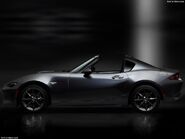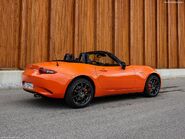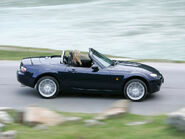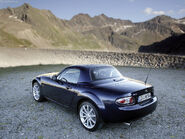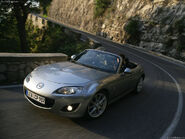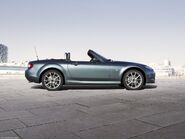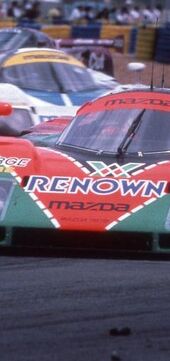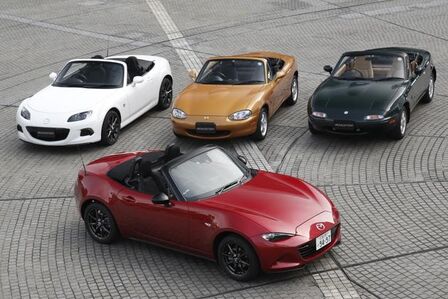
The Mazda MX-5 is a lightweight two-passenger roadster sports car manufactured and marketed by Mazda with a front mid-engine, rear-wheel-drive layout. The convertible is marketed as the Mazda Roadster (マツダ・ロードスター, Matsuda Rōdosutā) or Eunos Roadster (ユーノス・ロードスター, Yūnosu Rōdosutā) in Japan, and as the Mazda MX-5 Miata (/miˈɑːtə/) in North America, where it is widely known as the Miata.
Manufactured at Mazda's Hiroshima plant, the MX-5 debuted in 1989 at the Chicago Auto Show and was conceived and executed under a tightly focused design credo, Jinba ittai (人馬一体), meaning "oneness of horse and rider". Widely noted for its small, light, technologically modern, dynamically balanced and minimally complex design, the MX-5 has frequently been called a spiritual successor to 1950s and '60s Italian and British roadster sports cars. The Lotus Elan was used as a design benchmark.
Generations were internally designated with a two-letter code, beginning with the first generation, the NA. The second generation, (NB), launched in 1998 for MY 1999; followed by the third generation (NC) in 2005 for MY 2006, and the fourth generation (ND) in 2015 for MY 2016 (along with "ND2" being the designation for MY 2019).
As the best-selling two-seat convertible sports car in history,[1] the MX-5 has been marketed globally, with production exceeding one million, as of early 2016.[2] The name Miata derives from Old High German for "reward".[3][N 1]
See Autopedia's comprehensive Mazda MX-5 Review.
Recent Changes
- For 2009, the MX-5 Miata receives its first mid-cycle facelift.[1]
- The biggest change to come about for 2007 is the addition of an MX-5 model built with a power retractable hardtop. Other features remain the same as the 2006 models.
- On May 29, 2007, Mazda released a special edition of the vehicle called the MX-5 Icon, in celebration of the Mazda Wankel Rotary Engine's 40th Anniversary on May 30.
Styles and Major Options
The 2007 MX-5 comes available in 4 trims: the SV, Sport, Touring, and Grand Touring. In addition, all trims with the exception of the SV are available in both softtop and hardtop versions. All come equipped with the same standard 2.0L 166hp I-4 engine and rear wheel drive, and while the SV and Sport trims have 5-speed manual transmissions, the Touring and Grand Touring feature a 6-speed manual transmission. Other standout features are as follows:
SV
- 16" silver alloy wheels
- 4-way front bucket seats
- Cloth seating and vinyl door trim
- Manual convertible roof
- 4-speaker AM/FM/CD audio system
- Power windows and mirrors
Sport
- Available power convertible hardtop roof
- Leather/metal-look steering wheel material
Touring
- 17" silver alloy wheels
- Leather shift knob, leather/metal-look steering wheel
- Available power convertible hardtop roof
- 6-speaker AM/FM/CD audio system with steering wheel controls
- Power windows, locks, and mirrors
Grand Touring
- Leather seating and leatherette door trim
- 7-speaker Bose AM/FM/CD audio system with amp and steering wheel controls
Pricing
Today's actual prices for the Mazda MX-5 can be found at CarsDirect.
|
MX-5 Trims |
||||||
|
SV |
Sport |
Touring |
Sport
|
Grand Touring |
Touring
|
Grand Touring
|
|
MSRP |
||||||
|
$20,435 |
$21,435 |
$23,240 |
$24,350 |
$24,500 |
$25,100 |
$26,360 |
|
Invoice |
||||||
|
$18,883 |
$19,804 |
$21,468 |
$22,490 |
$22,629 |
$23,181 |
$24,342 |
Gas Mileage
As seen on the FuelEconomy.gov website, the City/Highway MPG averages are as follows:
|
Trim |
||
|
MPG |
||
|
25/30 |
24/30 |
22/30 |
Reliability
Although the latest generation of the MX-5 Miata is still too young to provide accurate long-term reliability information, Consumer Reports states that "first-year reliability has been average."
Safety
Although the NHTSA has yet to post safety information on the MX-5, Autos.com reports that the MX-5 places 5th in safety for its Sporty Car category. Some of the standard safety equipment found on the MX-5 includes:
- Front and rear anti-roll bars
- 4-wheel anti-lock brakes
- Driver/passenger front-impact airbags
- Driver/passenger side-impact airbags
- Occupancy sensors
- Side impact bars
- Ignition disable
Photos
Colors
Colors will vary according to trim, and a complete list is viewable at CarsDirect.com. Some of the available choices are: Exterior
- Brilliant Black
- Copper Red Mica
- Highland Green
- Stormy Blue Mica
- Sunlight Silver Metallic
- True Red
Interior
- Black
- Tan
Main Competitors
Hybrid Models
There are currently no hybrid models of the MX-5 in production.
Unique Attributes
In the Which? Car Owner's Satisfaction survey, the MX-5 is ranked 3rd place with a satisfaction rating of 96%.
Resale Values
According to Kelley Blue Book, "as for the MX-5's long-term value, Kelley Blue Book expects the MX-5 to retain strong residual and resale values in the first three years, but then drop to average in years four and five."
Criticisms (pre-2006)
- "Practicality doesn't apply here." - New Car Test Drive
- "Its tonneau cover is a bit fiddly to install, and at best, rudimentary." - Road & Track
- "If you're long of leg or over six feet in height, the MX-5 can still present you with a cramped driving position. The MX-5 has a small trunk and does not offer much in the way of interior storage space. If this is going to be your only mode of transport, you're not going to win many friends when it's your turn to drive the co-workers to lunch." - Kelley Blue Book
- "Ineffective windblocker" - Edmunds.com
Current Generation: (2016-Present)
The new MX-5 was presented at the October 2014 Paris Motor Show, and at the November 2014 Los Angeles Auto Show. The car is manufactured in Mazda’s Hiroshima plant.The vehicle was released in the third quarter of 2015. The MX-5 is priced between $24,915 and $30,065. On March 24, 2016 the MX-5 was awarded World Car of the Year (WCOTY) and the World Car Design of the Year at the New York Auto Show. It was the second Mazda to win WCOTH following the Mazda 2 in 2008.
The fourth generation MX-5 is 105 mm (4 inches) shorter and 100 kg (220 lb) lighter than its predecessor, putting the vehicle's estimated curb weight somewhere around just 1,000 kg (2,200 lb). The car is based on the Mazda SKYACTIV technology. There are 2 direct-injection petrol engines without turbo-chargers. The base model has a 1.5 L 96 kW (129 bhp) engine, and the North American (USA and Canada) version has a 2.0 L 116 kW (155 bhp) engine.
A six-speed manual shift transmission was available from launch but a six-speed automatic transmission will be offered when the RF (Retractable Fastback) model becomes available late 2016 / early 2017. The cockpit, steering wheel, and infotainment system are very similar to the 2014 Mazda3.
Standard models come with a manually operated fabric roof which can be opened/closed within a few seconds, but the RF model comes with a targa-like electric lid, which can open at speeds of up to 6 mph (10 km/h) and leaves the roof’s coupe-like rear section in place.
A co-operation with Alfa Romeo on a joint rear-wheel drive platform was announced in 2012, but cancelled in 2014. FCA announced a Fiat 124 Spider and Abarth versions based on the Mazda ND platform in 2015.
Engine SpecificationsEdit
SafetyEdit
4 airbags are available for standard including torso airbags, pelvis airbags and head airbags for driver and passenger and headrests for whiplash protection. An Vehicle Stability Control+ (VSC+), an 'active' hood for pedestrian protection and a Lane Departue Warning System (LDWS) are available as standard. Since the MX-5 is a two-seater, the front passenger airbag can be disabled for safe transportation of children and the installation of a suitable rear-facing child seat restraint to be used in that position. In the Euro NCAP safety test, the MX suffered from a malfunctioning driver's airbag, which was unable to prevent the dummy from hitting the steering wheel. It gained 4 of 5 stars available.
MX-5 RF
In late 2016, a new MX-5 RF (Retractable Fastback) model was announced. It features a rigid roof and buttresses that give the silhouette a more coupé-like appearance than the soft top convertible. The top panel of the roof folds back while the buttresses remain in place, similar to a Targa top. Antecedents for the flying buttresses design are found in the Chevrolet Corvette (C3) T-top coupé and the Ferrari Dino 206 GT and 246 GT. The interior of the MX-5 RF model is almost the same as the soft top, with the same media screen, seats, steering wheel and switchgear, and the trunk volume is the same as the soft top. Differences include a full circle colored digital gauge in place of the soft top's semi-rectangular, half-digital, mono-colored display. The storage cubby behind the drivers seat has been eliminated, and the cubby behind the passenger seat as well as the glove box behind the center console have been made shallower to make room for the roof mechanism. The MX-5 RF uses the same engines as the soft top model and offers similar performance. The MX-5 RF also introduced a new 'Machine Grey Mica' paint.
A limited edition run of 500 models was introduced with the launch of the Mazda MX-5 RF. Called the 'Launch Edition' these models were priced at £28,995 and were only available with the 118 kW (158 hp; 160 PS) 2.0-litre engine. These models included BBS alloy wheels, a twin-tone roof, black door mirrors and rear spoiler as well as Recaro seats. This version was only available in two colours: 'Soul Red' or 'Machine Grey'. It was the first time since the original NA series MX-5 was available with a companion body style since the Mazda MX-3 which was a hatchback sport coupe.
Mazda MX-5 30th Anniversary Edition (2019)
To celebrate the 30th anniversary of the MX-5, Mazda released a limited edition variant of the ND. The MX-5 Miata 30th Anniversary Edition debuted at the 2019 Chicago Auto Show on 7 February. The car comes in an exclusive Racing Orange color with a special numbering badge, as well as specially engraved Rays Engineering forged aluminum wheels and updated orange Brembo front and orange Nissin rear brake calipers.[28] Each U.S. market owner was able to configure their 30th Anniversary Edition MX-5 before placing a $500 deposit. Of the 3,000 worldwide units, only 500 examples were allocated to the U.S., but after feedback from buyers, Mazda announced that an additional 143 units will be allocated for the U.S. market. 165 examples were exported to Canada, 30 went to Australia, and 30 were sold in the Philippines - including the 3,000th unit.
Mazda MX-5 Eunos Edition (2020)
Available exclusively in France with a limited run of 110 units, the MX-5 Eunos Edition features a Jet Black Mica exterior, burgundy Napa leather interior, and black Rays Engineering wheels as an homage to the Eunos brand and the 1992 S-Limited Roadster.
Mazda MX-5 100th Anniversary (2020 / 2021)
To commemorate Mazda's 100 year past and pay homage to their R360 Coupe, Mazda released the 100th Anniversary Mazda MX-5 Miata and MX-5 Miata RF in the third quarter of 2020.[35] Based on their 2020 Grand Touring models this edition is only offered in their Snowflake White Pearl Mica colour and paired with their Garnet Red Napa leather seats.[36] Canada received them for the 2021 model year. This colour combination was inspired by the original R360 Coupe. There are several interior accents with the special 100th Anniversary badges and logos throughout. The "100 YEARS 1920–2020" anniversary logo is imprinted in the headrest of the seats, and have it on the key fob, and central caps of the wheels. The "1920–2020" badges are throughout the car, it being on the red accent rugs, and front fenders of the car. The convertible version of this edition has the exclusive burgundy top, while the retractable fastback (RF) version will have a black piano top color. Less than 700 of these editions over all Mazda Models (MX-30, 2, 3, 6, CX-3, CX-30, CX-5, CX-9, and MX-5) are built and distributed worldwide.
Third generation (NC)
The Mazda MX-5 (NC) is the third generation of the Mazda MX-5 manufactured from 2005 to 2015. At its introduction in 2005, it won the Car of the Year Japan Award and made Car and Driver's 10Best list from 2006 to 2013. The NC is the first MX-5 generation to feature a retractable hardtop variant, with its roof being able to fold and unfold in 12 seconds without sacrificing trunk space.

2006—2008 (NC1)
The exterior styling by Yasushi Nakamuta resembled the original design, but unlike the update from NA to NB, which was mostly a nose/tail/interior change, the NC shares no components with the NB, except for the fender-mounted turn signal lights on non-U.S. models, and rear differential internals. The chief designer of this model generation was Moray Callum. The 2003 Mazda Ibuki concept served as a preview of the new model. The suspension changed from a four-wheel double wishbone setup to a front wishbone/rear multilink setup, shared with the Mazda RX-8. Technologies including traction control and stability control were added to increase driveability. According to Car and Driver, the NC has a skidpad number of 0.90g.
For the U.S., the engine was the 16-valve, 2.0 L (120 cu in) MZR LF-VE DOHC I4, producing 130 kW (170 bhp) and 190 N⋅m (140 lbf⋅ft) of torque coupled to either a 5-speed or a 6-speed manual transmission or 118 kW (158 bhp) with the optional 6-speed automatic transmission. A limited-slip differential was available with the 6-speed manual option. In Australia, the 2.0 L (120 cu in) MZR was offered, rated at 118 kW (158 bhp) and 188 N⋅m (139 lbf⋅ft) of torque and the 6-speed manual transmission and LSD are standard. In Europe, two engines were offered: the 2.0 L (120 cu in) MZR LF-VE rated at 118 kW (158 bhp) and 188 N⋅m (139 lbf⋅ft) of torque, coupled to the 6-speed manual transmission; and a new 1.8 L (110 cu in) MZR L8-VE, rated at 94 kW (126 bhp) and 167 N⋅m (123 lbf⋅ft), coupled to the 5-speed manual transmission.
A six-speed automatic transmission, with steering wheel mounted paddle shifters, was optional.[8] A test by Car and Driver magazine revealed a 0-97 km/h (60 mph) time of 6.5 s for the 2.0 L (120 cu in) U.S.-spec NC.[9] Manufacturer figures for the European-spec model are: 0-100 km/h (62 mph) in 9.4 s for the 1.8 and 7.9 s for the 2.0. As of this generation, the car no longer complies with Japanese law's maximum exterior width dimension for the mid-size vehicle tax class, making Japanese buyers liable for additional costs for ownership.
Power Retractable Hard Top
In July 2006, Mazda debuted a Power Retractable Hard Top (PRHT) version of the NC with a two-piece[10] folding hardtop, named MX-5 Roadster Coupé in Europe, Roadster Power Retractable Hard Top in Japan, and MX-5 Miata Power Retractable Hard Top in the U.S. and Canada. Designed by Webasto[11] and constructed of polycarbonate,[12] the top requires 12 seconds to raise or lower, and the first models were delivered to customers in late August 2006. The hardtop adds 36 kg (79 lb) to the weight of a comparably equipped soft-top, without diminishing trunk space when retracted. The PRHT omits one of the soft-top's two storage compartments behind the seats to accommodate the folding roof mechanism and has a steel trunk lid instead of the soft-top's aluminum. Performance times are slightly affected with the weight increase, with the 0-100 km/h (62 mph) time increased to 9.6 s for the 1.8 and 8.2 seconds for the 2.0. Thanks to better aerodynamics, though, top speed is increased from 196 km/h (121.8 mph) to 200 km/h (124.3 mph) for the smaller-engined model and from 210 km/h (130 mph) to 215 km/h (134 mph) for the 2.0. These figures are for the European-spec models. For all PRHT models, the suspension was slightly modified to handle the additional weight, with slightly stiffer springs.
2008 facelift (NC2)

The MX-5 facelift was unveiled at the 2008 Paris Motor Show and Science Museum in London,[20] and later at the 2009 Chicago Auto Show. The Japanese model went on sale on December 9, 2008 at Mazda and Mazda Anfini dealers.
Major changes concern the restyled front which now incorporates elements from Mazda’s newer models like the larger grille and new head and fog lights. Further restyled elements include the side skirts, rear bumper and the tail lights. The soft-top Touring and Grand Touring models feature a mesh grille bordered by a chrome frame. The hardtop PRHT Roadster Coupe now features a mesh grille bordered by a chrome frame and chrome elements inside the headlamps and outer door handles.
The 2.0 L; 122.0 cu in (1,999 cc) I4 engine was rated 125 kW (167 bhp) at 7,000 rpm and 190 N⋅m (140 lb⋅ft) at 5,000 rpm for the 5-speed manual transmission,[23] 118 kW (158 bhp) at 6,700 rpm with the fuel cut-off at 7,200 rpm and 190 N⋅m (140 lb⋅ft) at 5,000 rpm for the automatic transmission. Engine redline was raised by 500 rpm to 7,200 rpm in manual model and fuel cut at 7,500 rpm. The suspension and gearbox have been fine-tuned; with the latter offering smoother shifts and an automatic transmission will be introduced in Europe for the first time.
Mazda Roadster 20th Anniversary (2009)
The 20th Anniversary Model is a limited version of the MX-5 soft-top with a MZR 1.8L engine with only 2000 produced. It was built for the European market to commemorate 20 years of MX-5 production. It includes a special exterior styling package with a chrome grille, door handles and headlight fascia, silver-look fog lamp frames, unique 17-inch alloy wheels and 20th Anniversary logos and a strut tower bar. Available body colors include True Red, Crystal White Pearl and, specific for this edition, a new Aurora Blue (with matching painted decorative elements in the interior).
MX-5 Miyako (2010)
The MX-5 Miyako is a limited edition of the MX-5 Soft-Top Convertible available in two versions, the MX-5 1.8i Miyako and the 2.0i Miyako. 500 units of each were produced. The 1.8i Miyako features a MZR 1.8-liter engine and a powered retractable hardtop, while the 2.0i Miyako is powered by the MZR 2.0-liter engine. It was built for the UK market to commemorate 20 years of MX-5 production. The Miyako package included Medici premium perforated black leather trim with a red underlay and stitching, special badging, floor mats and climate control air-conditioning. The exterior includes front fog lamps, larger 17-inch alloy wheels, a front suspension strut brace, and metallic paint Aluminum Silver Metallic on the 2.0i Miyako and Velocity Red Mica on 1.8i Miyako). Both Miyako models also included remote central locking, a leather steering wheel with audio controls, an MP3 compatible audio system with six speakers and auxiliary (AUX) jack input, heated electric mirrors and electric front windows and a Thatcham Category 1 alarm with immobiliser. The 2.0i Miyako also included a limited-slip differential, Dynamic Stability Control and Traction Control.
2013 model year update
New features included using coordinated black and silver features to the respective soft-top and power retractable hardtop cars, front bumper has a bigger grille opening as well as a revised fog lamp design and new lip spoiler, a new luxury tan color interior option, implementing Active Bonnet for pedestrian protection, and weight reduction via re-designed front bumper, new 17-inch aluminum wheels and even with the internal wiring. While no modifications were done to the powerplant, Mazda did retune the ECU on the manual transmission MX-5 to provide a more linear throttle response. Braking performance has also been altered, with the brake booster being modified to better modulate braking performance on the roadster. U.S. market Touring trim was replaced by Club trim with addition of black headlamps, black side mirror covers, 17"x7" gun metal black alloy wheels, Bilstein dampers, limited-slip differential, body color dash trim, red stitched black cloth seats, MX-5 decals, and more pronounced front and rear aerodynamic splitters. Colors for the new Club trim were limited to True Red, Brilliant Black, Crystal White Pearl, and Liquid Silver Metallic. There are only two choices for tops: black cloth top or black PRHT.
Super20 Concept
Unveiled at the 2010 SEMA Show, the MX-5 Super20 included a DPTune-reflashed ECU with a supercharged Cosworth motor, ACT clutch, MAZDASPEED coilover shocks and shock tower brace, and Racing Beat hollow anti-roll bars. It also featured StopTech brakes, SpeedSource brake disks and 16-inch Enkei wheels.
Second generation (NB)

In 1998, Mazda released the updated model year 1999 MX-5 Miata. This model is known as the NB (referring to the model number printed on the VIN plate) or Mark 2. With its introduction, the earlier MX-5 Miata became known as the NA or Mark 1. The NB features a more powerful engine and more modern styling cues borrowed from the aggressive RX-7. For the model year 2000, Mazda released a limited run of 10th anniversary models featuring various styling and performance upgrades, most notably a close-ratio 6-speed manual transmission and Torsen limited-slip differential. The 5-speed transmission was retained for all other NB models except the turbocharged 2004-2005 Mazdaspeed variants. In Japan, the Eunos name was dropped from the NB, as the marque was considered a commercial failure, but the successful Roadster was incorporated into the Mazda brand. Prices in the United States, the main market for the Miata, started at US$19,770.
1999 Miata (Generation 2)
Body and chassis
Although many parts of the interior and body were different, the most notable changes were the headlights: the first model's retractable headlights had been exchanged for fixed ones. The new car had grown slightly in width compared to the earlier model with dimensions: length 3955 mm (155.7 in); width 1680 mm (66.1 in); height 1235 mm (48.6 in) and wheelbase 2265 mm (89.2 in). Ground clearance was a slightly reduced 135 mm (5.3 in). With the minimum of options, the NB weighed 1000 kilograms. The new model was slightly more aerodynamic than the original, with a Cd figure of 0.36.
Suspension and wheels
The second generation Miata continued to employ four-wheel independent suspension, with enlarged anti-roll bars of 22 mm (0.87 in) at the front and 11 mm (0.43 in) at the rear. The wheel, tire and brakes package on the second generation Miata was significantly upgraded. Front brakes were of 255 mm (10 in) diameter with 251 mm (9.9 in) at the rear. ABS was offered as an option. Alloy wheels were now of 14 inch or 15 inch diameter and 6 inch width, depending on the model. Sports models were equipped with the larger wheels and 195/50VR15 tires.
Engine
The BP-4W engine remained at 1.8 L but received several minor updates. The engine compression ratio was raised from 9.0:1 to 9.5:1 by adding slightly domed pistons. The intake cam was changed to a solid lifter design with a stronger cam. The intake runners in the head were straightened and the intake manifold was mounted higher up. The new intake manifold received a set of flappers that could uncover a resonance chamber - this was needed to fix a dead spot in the torque curve that the new head created. Power output of the new engine is quoted at 105 kW (140 hp) with 119lbft of torque.
The 1.6 L B6 engine remained available in some markets, including Japan.
Performance
The second generation Miata with the 1.8 L engine could reach 60 mph (96 km/h) in 7.9 seconds and had a top speed of 123 mph (197 km/h).
Generation 2.5 (NB)
Example of UK Spec Mk2.5 - special edition Euphonic. 1.8i
In 2001, a facelift to the NB was released. There were some minor design changes, with the 18 July 2000 press release announcing the new model describing the changes as "resulting in an even sportier and more forceful look". Some cockpit elements were also changed, with instrument panel gauges having a white face and red numbers. The seats were also upgraded, incorporating more support in the side bolsters, and taller headrests. Added this year for top models were 16 inch (406 mm) wheels with 205/45VR16 low-profile tires and larger brakes (10.6 inch diameter at the front and 10.9 inch at the rear). The upgraded tires and suspension allowed the new model to pull 0.88 g in lateral grip in tests by Car and Driver. The body was strengthened, gaining 16% in bending rigidity and 22% in torsional rigidity. With the minimum of options the 2001 model weighed 1065 kilograms.
The 1.8 L BP-Z3 engine was slightly modified and now featured variable valve timing on the intake camshaft. The intake and exhaust system also received a minor upgrade. These modifications resulted in power output of 117 kW (155 bhp) for models delivered in Japan and Australia. The same engine produced 110 kW (146 hp) in vehicles sold in the United States and Europe (likely due to more restrictive emission standards). In the United States, Mazda erroneously quoted the power figure for the Japanese and Australian model in early catalogues. Car and Driver magazine and numerous owners confirmed the missing power, and Mazda was forced to buy back a number of 2001 cars due to these misleading power claims. Owners who did not take up the buy back offer were offered an apology and free servicing for the warranty period.
32,000 2001 and 2002 model year Miatas were recalled in December of 2005 for excessive emissions.
Mazdaspeed MX-5
2004 saw the introduction of the turbocharged Mazdaspeed MX-5. It featured a light-pressure turbo BPT engine for 178 hp rather than the S-VT BP-Z3. Other features included a special suspension, upgraded transmission and clutch assemblies, upgraded drivetrain components, Racing Hart 17 inch wheels, special interior trim, and special exterior paint.
Though not officially a "Limited Edition" production run, only a small number of Mazdaspeed Miatas were produced during model years 2004 and 2005. In 2004, 4000 cars where built and in 2005, 1428.
First generation (NA)
The Mazda MX-5 (NA) (sold in Japan as the Eunos Roadster (ユーノス・ロードスター, Yūnosu Rōdosutā) and in North America as the Mazda MX-5 Miata) is the first generation of the Mazda MX-5 manufactured from 1989 to 1997. Inspired by the post-war era British sports cars, the MX-5 rejuvenated interest in roadsters after the demise of cars such as the MG B and Triumph Spitfire. Since its debut, the MX-5 has won numerous automotive awards and has become the world's best selling sports car.
Background
The MX-5 was unveiled at the Chicago Auto Show on February 10, 1989, with a price tag of US$14,000. The MX-5, with production code NA, was made available for delivery to buyers worldwide in the following dates: May 1989 (as a 1990 model) in the US and Canada; September 1, 1989 in Japan; and 1990 in Europe. An optional hardtop was made available at the same time, in sheet moulding compound (SMC). Demand initially outstripped production, fueled by enthusiastic press reviews.
In Japan, the car was not badged as a Mazda, as the company was in the process of launching different marques for deluxe models, similar to Nissan's Infiniti, Honda's Acura and Toyota's Lexus. Instead, the Mazda MX-5 was sold as the Eunos Roadster, and was joined by the MX-3/AZ-3/Eunos Presso (based on Japanese Mazda dealerships). The exterior dimensions and the engine displacement were also in compliance with Japanese Government compact car regulation.
The body shell of the NA was all-steel with a lightweight aluminum hood. Overall dimensions were 3,970 mm (156 in) in length, 1,675 mm (65.9 in) in width, and 1,235 mm (48.6 in) in height. Without options, the NA weighed only 980 kg (2,160 lb). It had a drag coefficient of Cd=0.38. Suspension was an independent double wishbone on all four wheels, with an anti-roll bar at the front and rear. Four-wheel disc brakes, ventilated at the front, were behind alloy wheels with 185/60HR14 radial tires. The base model came with stamped steel wheels from the then-current 323/Protege.
The original MX-5, with standard manual transmission, came with a 1.6 L (98 cu in) DOHC inline four-cylinder engine, producing 86 kW (115 bhp) at 6,500 rpm, and 136 N⋅m (100 lbf⋅ft) of torque at 5,500 rpm. The engine employs an electronic fuel injection system using a vane-type air flow meter and an electronic ignition system with a camshaft angle sensor instead of a distributor. This engine, codenamed B6ZE(RS), was specifically designed for the MX-5 and featured a lightened crankshaft, flywheel, and aluminum sump with cooling fins. An MX-5 with the optional automatic transmission had its 1.6L engine tuned to develop peak torque at lower rpm's (136 Nm, 100 lbf-ft at 4000 rpm) to better mate with the automatic transmission gearing and torque requirements. This tuning resulted in a lower peak power of 78.5 kW (105 bhp) at 6500 rpm.
The standard transmission was a 5-speed manual, derived from the one used in the Mazda 929/Luce (also rear-wheel drive).[6] The gear shift was the subject of close attention during development, with engineers told to make it shift in as small a gear pattern as possible and with minimal effort.[7] In Japan and the US, an optional automatic transmission was also offered. The Japanese and American markets also received an optional viscous limited-slip differential, although it was only available for cars with a manual transmission. To achieve the low introductory price, the base model was stripped. It had steel wheels, manual steering, roll-up windows, and no stereo or air conditioning. Power steering, air conditioning, and stereo were added as standard equipment in later years.
For the 1994 model year, the first-generation MX-5 was freshened with the introduction of the more powerful 1,839 cc (1.8 L; 112.2 cu in) BP-ZE engine, dual airbags placed in a redesigned dashboard, the addition of a Mazda badge on the front fascia in the US and a limited-slip differential in some markets. The chassis was substantially braced to meet new side-impact standards, most visibly by adding a "track bar" between the seatbelt towers inside the car, but also to the front and rear subframes. Also, 1994 and 1995 were the only years in which Mazda offered a light metallic blue paint (Laguna Blue Mica), making these cars rare collectors cars to some. 1994 also saw the introduction of the "R" package, a sport-themed package with Bilstein shocks, stiffer sway bars, retuned springs, subtle front and rear underbody spoilers, and a Torsen LSD. Air conditioning was optional, but the "R" package was not available with power steering, leather, or an automatic transmission. It can also be identified by a red Miata badge on the rear instead of the usual black. No body style changes were made, however. Halfway through the 1997 model year the hazard light button was changed to a black button with red symbol as opposed to the earlier red button with white symbol.
The new 1,839 cc (1.8 L; 112.2 cu in) engine produced 96 kW (129 bhp) at 6,500 rpm and 149 N⋅m (110 lbf⋅ft) of torque at 5,500 rpm, which was then increased to 99 kW (133 bhp) at 6,500 rpm and 155 N⋅m (114 lbf⋅ft) of torque at 5,500 rpm for the 1996 model year. The base weight increased to 990 kg (2,180 lb). Performance was thus improved slightly, because the additional weight was more than offset by the extra power. In some markets such as Europe, the 1.6 L (98 cu in) engine continued to be available as a lower-cost option, but was detuned to 66 kW (89 bhp). This lower-powered model did not receive all the additional chassis bracing of the new 1.8 L (110 cu in). Japanese and U.S. models offered an optional Torsen LSD, which was far more durable than the previous viscous differential.
There were a number of trim levels and special editions available, determined by local Mazda marketing departments. In the US, the base model was offered for US$13,995 at launch and was very basic, with manual windows, steel wheels, and without air conditioning or power steering. The "A Package" offered power steering, a leather-wrapped steering wheel, aluminum alloy wheels and cassette stereo. The "B Package" added power windows, along with cruise control and headrest speakers, while the "C Package" included a tan interior and top with leather seats. The "R Package" was for racing, and the annual special editions were formalized as "M Editions". These included all of the luxury options from the "C Package" as well as special paint and, sometimes, special wheels. In the UK, to celebrate Mazda's 24 hours of Le Mans win, Mazda brought out a special edition of the MX-5, with the winner's color scheme (see Mazda 787B) and came equipped with BBR (Brodie Brittain Racing) turbo conversion; the car is one of the most sought after special edition cars of the MX-5s.
car
competition.
car.
decided.
et.
chassis
0.38.
wheels
Performance
Worldwide
MX-5 SP
Mazda MX-5 SP
In 2001 Mazda Australia produced a limited run (100 cars) of turbocharged MX-5s labelled the SP. These were said to be the inspiration for the Mazdaspeed MX-5 however they only had an upgraded intake/turbo and exhaust unlike the Mazdaspeed MX-5 which has a stronger engine, gearbox and diff, with upgraded cooling system, interior and bodykit. Over 215 parts went into upgrading the performance of the SP creating a powerful sportscar that looked identical to a standar. The driveline, braking, suspension and engine internals remained standard. The upgraded engine was rated at 150 kW (201 hp).
Mazda Roadster Coupe
Mazda Engineering and Technology Co. Ltd. (Mazda E&T), a division of Mazda Japan, produced a limited run of Mazda Roadsters for the Japanese market with a permanent fixed hardtop roof. The body structure was reworked to incorporate the roof for a substantial increase in chassis rigidity and a weight increase of 10 kg. A range of models were produced, from a basic 1.6 L version, to heavily restyled boutique models. No Roadster Coupes were exported, though an example upgraded to Mazdaspeed specifications was shown to international audiences.
Design quirks and oddities
Since production began, over 700,000 Miatas have been made, leading the Guinness Book of Records to name it the world's best-selling sports car on February 13 2002.
English comedian Jonathon Ross owns a duck egg blue MX-5 with ponyskin seats.
According to the Herald Sun, a 1989 Mazda MX-5 is regarded as a modern collectable. The car, costing $29,550 AUD when new can be had for $68,000 to $9,200 AUD.
Awards
The Miata has been on Car and Driver magazine's annual Ten Best list seven times: The NA from its introduction in 1990 through 1992; the NB on its introduction in 1998 as well as 1999 and 2001; and the NC on its introduction in 2006. The NA was also Wheels Magazine's Car of the Year for 1989 with the NC taking the award for 2005. Wheels Magazine also named the car the Best Overall Design in the 2006 Wheels Automotive Design Awards.
In the November 2004 edition of Sports Car International magazine, the Miata was chosen as the best sports car of the 1990s. In the March 2005 edition of the same magazine, the six-decade countdown culminated in the "Ten Best Sports Cars of All Time" issue, of which the Miata secured the number 10 spot, bested only by the likes of exotics and otherwise unobtainable icons of automotive history.
The NC was named the 2005-2006 Japan Car of the Year.
The Mazda Miata (MX-5) had been voted the winner of the 2003 J.D. Power Initial Quality Study for a sports car.
Production numbers
| Year | Production |
|---|---|
| 1988 | 12 (pre-production models) |
| 1989 | 45,266 |
| 1990 | 95,640 |
| 1991 | 63,434 |
| 1992 | 52,712 |
| 1993 | 44,743 |
| 1994 | 39,623 |
| 1995 | 31,886 |
| 1996 | 33,610 |
| 1997 | 27,037 |
| 1998 | 58,682 |
| 1999 | 44,851 |
| 2000 | 47,496 |
| 2001 | 38,870 |
| 2002 | 40,754 |
| 2003 | 30,106 |
| 2004 | 24,232 |
| 2005 | 29,950 |
| 2006 | 48,389 |
| Total | 797,293 |
For a breakdown of the production numbers, by color and by option package, see the Miata.net Mazda MX-5 Miata FAQ.
The 250,000th MX-5 rolled out of the factory on November 9 1992; the 500,000th, on February 8 1999; the 750,000th, in March 2004; and the 800,000 in January 2007.
In Popular Culture
- Cars - Secondary characters Mia and Tia (a play on the name Miata) a pair of NASCAR fans are animated Miatas.
- Go - A character in this early Katie Holmes-starring film is murdered and their body is stashed in the trunk of a Sunburst Yellow 1992 Miata.
- The Benchwarmers - One of the main character's bat flys out of his hands and goes through the windshield of a Miata parked nearby. A player on the opposing team yells, "That's my Miata!," and the team beats up the Miata-owner.
- Need For Speed Underground and Need For Speed Underground 2 - In these video games, you can buy and upgrade Miatas.
- Gran Turismo 4 - In this videogame you can buy and upgrade most Miata models.
- Juiced - In this video game, you can buy and upgrade Miatas.
- Forza - Another video game featuring buying and upgrading the Miata.
- Yes, Dear - Greg buys a Miata, which many think is for Kim, but he says that he bought it for himself. Jimmy tells him that he made a bad choice, and that the Miata is a "chick car", but he ignores him. Later, while he is driving the Miata, a young girl tells him how his car is nice, and how it looks like her Barbie's, and the radio breaks, causing it to play Girls Just Wanna Have Fun by Cyndi Lauper at a very loud volume.
- Sister Sister - Tia and Tamara Mowry have a red miata that their parents purchased for them.
- A silver MX-5 appeared in one episode of the british sketch comedy show Harry and Paul owned by a gay Clarkson (a satirical person portrayed as a Jeremy Clarkson). Once he's given a spray of 'No Gay Spray', he walked away from his MX-5 saying "Girl's car" in a more manly voice.
Film and television appearances
Cars

Mia and Tia
Mia and Tia are characters in Cars. They also make a cameo in Cars 2. They are voiced by Lindsey Collins and Elissa Knightrespectively.
See also
- Mazda
- Spec Miata
References
- Long, B. MX-5 Miata - The full story of the world's favourite sports car, Veloce Publishing, 2002. ISBN 1-903706-21-1
- Carey, J. (March, 2005). "New Mazda MX-5". Wheels (Australia), p. 48.
External links
- 2017 Mazda MX-5 Miata RF Review
- Mazda Japan official Roadster site
- Mazda USA official MX-5 site
- Mazda UK official MX-5 site
- Mazda Australia official MX-5 site
- Miata.net an MX-5/Miata resource and owner community
- Turbo Miata online community
- Mazda Eunos Roadster specs
- MX-5.community an owner community sponsored by Mazda Motor Europe
- Mazda Tuning Parts
- OzMazda.com - Australian Online Mazda Community
- Mazda Miata / MX-5 RHT "Prestige Edition"
- 2009 Mazda Miata / MX-5 Officially Revealed
- Refreshed Mazda MX-5 Roadster goes on sale in Japan
- Mazda Launches MX-5 /Miata Facelift in Japan - New JDM Image Gallery
- 2009 Mazda MX-5 Miata: Celebrating 20 Years With A Chi-Town Party
- Mazda MX-5 Miata, Carsguide - Car of the Week
- New Mazda MX-5 Miyako Special Edition Models
- Power to the People: BBR-Cosworth Supercharge Mazda MX-5 to 235HP

|
This page uses some content from Wikipedia. The original article was at Mazda MX-5 Miata. The list of authors can be seen in the page history. As with Autopedia, the text of Wikipedia is available under the GNU Free Documentation License. |












